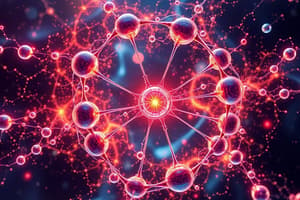Podcast
Questions and Answers
What type of intermolecular force occurs between polar molecules?
What type of intermolecular force occurs between polar molecules?
- Covalent Bonds
- Dispersion Forces
- Dipole-Dipole Attractions (correct)
- Ionic Bonds
Which type of bonding occurs when hydrogen is bonded to highly electronegative atoms like F, O, or N?
Which type of bonding occurs when hydrogen is bonded to highly electronegative atoms like F, O, or N?
- Dipole-Dipole Attractions
- Metallic Bonds
- Hydrogen Bonding (correct)
- Covalent Bonds
What is a characteristic property of water resulting from hydrogen bonding?
What is a characteristic property of water resulting from hydrogen bonding?
- Inability to dissolve substances
- High surface tension (correct)
- Higher density than ice
- Low boiling point
How do dispersion forces compare to dipole-dipole attractions?
How do dispersion forces compare to dipole-dipole attractions?
What happens to the density of ice compared to liquid water due to hydrogen bonding?
What happens to the density of ice compared to liquid water due to hydrogen bonding?
Which of the following is NOT a characteristic of hydrogen bonding?
Which of the following is NOT a characteristic of hydrogen bonding?
What distinguishes a polar molecule from a nonpolar molecule?
What distinguishes a polar molecule from a nonpolar molecule?
What is the effect of increasing the number of electrons in a molecule on dispersion forces?
What is the effect of increasing the number of electrons in a molecule on dispersion forces?
Which type of intermolecular force is present in HBr?
Which type of intermolecular force is present in HBr?
What is the correct order of melting and boiling points from highest to lowest for the following substances: H2O, NaCl, ICl, and CCl4?
What is the correct order of melting and boiling points from highest to lowest for the following substances: H2O, NaCl, ICl, and CCl4?
Why do ionic compounds generally dissolve in polar solvents like water?
Why do ionic compounds generally dissolve in polar solvents like water?
Which of the following interactions has the lowest melting point/boiling point?
Which of the following interactions has the lowest melting point/boiling point?
Arrange the following substances according to decreasing strength of intermolecular forces: NH3, I2, and PBr3.
Arrange the following substances according to decreasing strength of intermolecular forces: NH3, I2, and PBr3.
Which statement about solubility is true?
Which statement about solubility is true?
Which type of intermolecular force is primarily responsible for the higher boiling point of water compared to carbon dioxide?
Which type of intermolecular force is primarily responsible for the higher boiling point of water compared to carbon dioxide?
In the context of medical devices, why is it important for the materials used to have high melting points?
In the context of medical devices, why is it important for the materials used to have high melting points?
Flashcards are hidden until you start studying
Study Notes
Intermolecular Forces of Attraction
- Known as "Van der Waals Forces", arising from weak electrostatic attractions between molecules.
- Different from intramolecular forces (covalent bonds) which exist within a molecule.
Forces Between Polar Molecules
- Dipole-Dipole Attractions: Occur between polar molecules that have permanent dipoles, characterized by asymmetrical shapes and polar bonds.
- Hydrogen Bonding: A strong type of dipole-dipole interaction that occurs when hydrogen atoms bond with highly electronegative atoms (F, O, N).
- Results in very polar bonds and unusually high melting and boiling points (MP/BP).
- Water and ethanol are examples where hydrogen bonding occurs, affecting miscibility and physical properties.
- Hydrogen bonds allow ice to float due to its less dense, ordered structure compared to liquid water.
Properties of Water
- Ice’s open structure optimizes hydrogen bonding, contributing to its lower density compared to liquid water.
- Hydrogen bonding plays a key role in water's surface tension and beading properties.
Forces Between Nonpolar Molecules
- Dispersion Forces: The only attractive forces among nonpolar molecules and noble gas atoms; recognized as the weakest intermolecular forces.
- The strength of dispersion forces correlates with the total number of electrons; more electrons strengthen the forces.
- Example: Cl2 (34 electrons, gas), Br2 (70 electrons, liquid), I2 (106 electrons, solid).
Molecular Interactions Activity
- Identify the type of intermolecular forces in listed molecules (NH3, HBr, I2, PBr3, CO2).
- Arrange compounds (CCl4, H2O, NaCl, ICl) by decreasing intermolecular forces of attraction (IMFA).
Solubility of Ionic Compounds
- Ionic compounds dissolve in water due to molecule-ion attractions, where polar solvent molecules interact with ions, creating hydrated ions.
- Polar solvents like water effectively pull ions from ionic crystals into solution.
Effects of Intermolecular Forces
- Melting and Boiling Points: Stronger intermolecular forces increase the difficulty of separating molecules, resulting in higher MP/BP values.
- Hydrogen bonding yields the highest MP/BP, followed by dipole-dipole interactions, and lowest for London dispersion forces.
Solubility Principles
- Solutes must form attractions with solvents to dissolve; polar solutes dissolve in polar solvents, while nonpolar solutes dissolve in nonpolar environments.
- Polar solvents also attract and dissolve ionic compounds.
Applications of Intermolecular Forces
- Important in the design of medical devices, construction materials, sports equipment, and electrical devices.
- Medical implants require materials with high melting points to endure sterilization, preventing infection and allergic reactions.
Studying That Suits You
Use AI to generate personalized quizzes and flashcards to suit your learning preferences.



